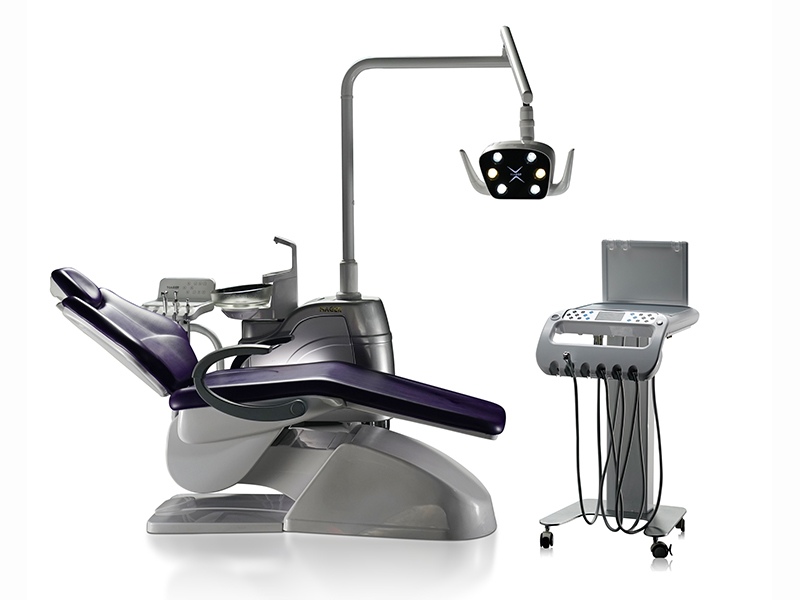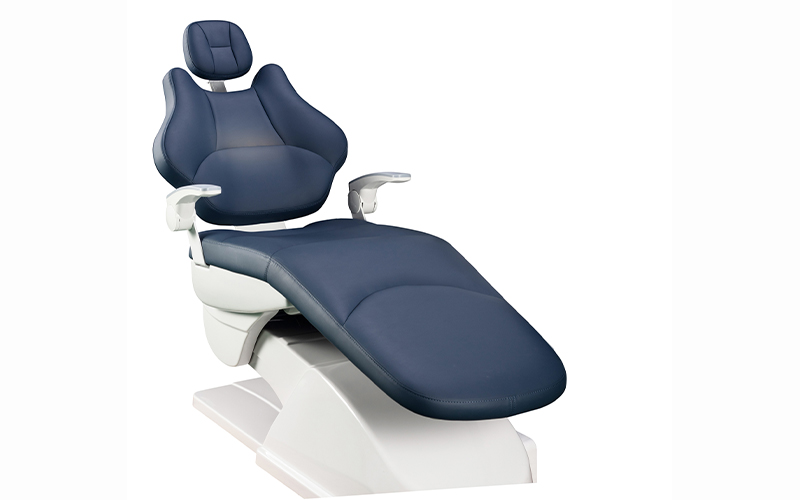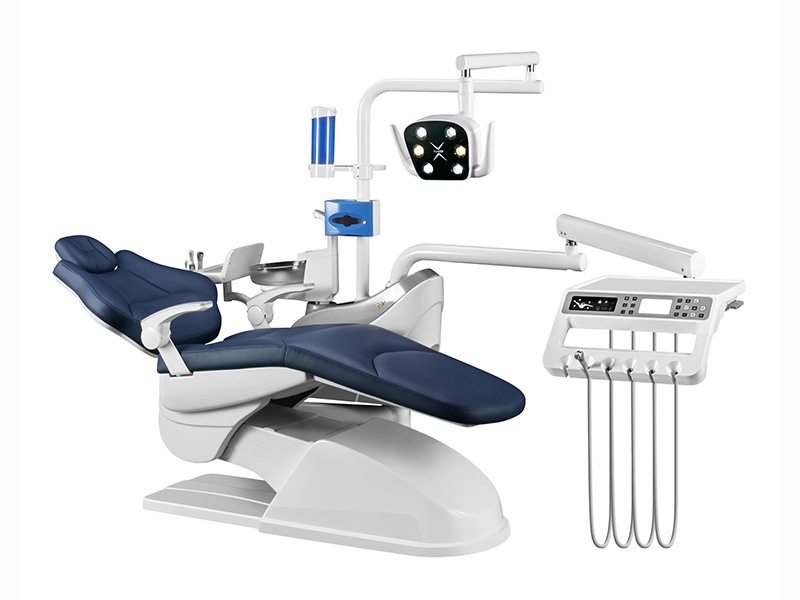What Is A Dental Chair?
A dental chair is a specialized medical device designed to support patients during dental procedures while enabling dentists to work efficiently and ergonomically. Beyond ordinary furniture, these sophisticated systems combine patient comfort with clinical functionality to facilitate examinations, treatments, and surgical interventions in modern dental practices.
Definition and Core Components
A dental chair is a specially designed medical device that supports the patient's entire body, similar to a recliner, but with adjustable joints allowing dentists to position patients optimally for various procedures. These chairs are typically mounted on a rotating base and connected to a dental engine—a supporting system that provides power, suction, water, and other essential functions for dental treatments.
Modern dental chairs from manufacturers like HAGER Dental are constructed using a combination of metal and plastic materials, often treated with antibacterial agents to minimize infection risks. The distinctive thin backrest design allows dental professionals to sit behind patients on dental stools, providing optimal access to the oral cavity during treatments.
Primary Functions and Applications
Patient Examination
Dental chairs serve as pivotal platforms for comprehensive oral examinations, creating a comfortable and conducive environment for both routine check-ups and detailed assessments. The strategic design enables dentists to perform thorough examinations while maintaining patient comfort throughout the process.
Treatment Delivery
The versatility of dental chairs accommodates diverse procedures ranging from routine cleanings and fillings to complex treatments such as root canals, extractions, and cosmetic interventions. Advanced models like the HAGER G7 Dental Unit support specialized tools and accessories to enhance treatment efficiency.
Accessibility and Comfort
Modern dental chairs prioritize ergonomic design with features like adjustable headrests, armrests, and lumbar support to ensure comfort during procedures of varying duration. Quality chairs accommodate patients of all ages and physical conditions, including children and individuals with mobility challenges.
Types of Dental Chairs
The dental industry offers several specialized chair designs, each tailored for specific clinical requirements and practice settings:
Standard/General Dental Chairs

Standard dental chairs represent the fundamental seating solution in most practices, offering reliability, simplicity, and cost-effectiveness. These versatile units feature cushioned seats and backrests with basic adjustability functions to accommodate routine dental procedures. Their straightforward design makes them easy to operate and maintain, reducing technical complications in busy practices.
Hydraulic Dental Chairs
Hydraulic dental chairs utilize fluid pressure systems to enable smooth, precise movements during patient positioning. Controlled through foot pedals or touchpads, these chairs allow dentists to adjust height, backrest angle, and footrest position without interrupting procedures. The hydraulic mechanism provides excellent stability, locking the chair securely in position during treatments.
Electric Dental Chairs

Electric dental chairs represent the cutting edge of dental seating technology, powered by precision motors that offer exceptional positioning control through digital interfaces. Advanced models feature memory functions that store preferred positions for individual patients, enhancing consistency across appointments. Additional features may include built-in massagers, heating options, and integrated multimedia screens to improve patient experience.
Portable Dental Chairs
Designed for mobility and flexibility, portable dental chairs are lightweight and foldable, making them ideal for mobile clinics, community outreach programs, and temporary setups. These chairs maintain essential comfort and functional features while enabling dental care delivery beyond traditional clinical settings.
Ergonomic Dental Chairs

Ergonomic dental chairs focus on promoting proper posture and reducing physical strain for both patients and dental professionals during procedures. These specialized units feature adjustable lumbar support, headrests, and armrests to maintain natural body alignment and prevent discomfort during extended treatments.
| Chair Type | Primary Benefits | Ideal Applications | Key Features |
|---|---|---|---|
| Standard | Cost-effective, reliable, simple operation | General dentistry, routine procedures | Basic adjustability, cushioned surfaces |
| Hydraulic | Smooth positioning, excellent stability | Multi-specialty practices | Foot/touchpad controls, precise adjustments |
| Electric | Ultimate precision, advanced features | High-end practices, complex procedures | Digital controls, position memory, integrated technology |
| Portable | Mobility, versatility, compact storage | Outreach programs, mobile clinics | Lightweight, foldable, quick setup |
| Ergonomic | Reduced strain, improved comfort | Long procedures, specialty practices | Lumbar support, optimal positioning features |
Historical Evolution
The modern dental chair represents over 190 years of continuous innovation. The first dental chair with movement capabilities was designed by James Snell in 1831, allowing minimal adjustments to the seat and back. A significant advancement came with James Beall Morrison's chair, patented in 1867, which introduced the compensating backrest and unprecedented vertical range adjustability.
Morrison's chair was revolutionary, allowing dentists to work from either standing or sitting positions—though most practitioners continued standing for nearly a century afterward. The chair featured ornate ironwork complemented by various upholstery options, including brown rexine (imitation leather) and caned seating surfaces for summer use.
Modern Features and Innovations
Contemporary dental chairs from manufacturers like HAGER Dental incorporate advanced features that enhance both clinical efficiency and patient comfort:
Integrated Technology Systems
Modern units feature built-in connections for handpieces, suction systems, and specialized tools to create streamlined workflows. Advanced models incorporate intraoral cameras and LED curing lights directly into the chair's delivery system.
Programmable Controls
Digital interfaces allow precise control of chair positions, with programmable presets for different procedures and practitioners. HAGER's premium models like the P1 Dental Unit feature touchscreen controls with intuitive interfaces for seamless adjustments during treatments.
Enhanced Patient Experience
Modern chairs include features specifically designed to reduce anxiety and improve comfort during dental visits. These may include pressure-distribution cushioning, climate-controlled surfaces, and even entertainment systems to distract patients during procedures.
Selecting the Right Dental Chair
When choosing dental chairs for a practice, several critical factors warrant consideration:
Quality and Durability
Invest in chairs constructed with high-quality materials that withstand the rigors of daily clinical use. HAGER chairs undergo extensive testing to ensure longevity and reliability in demanding practice environments, as evidenced by their quality certifications.
Ergonomic Design
Prioritize chairs that support proper positioning for both patients and practitioners. Ergonomic features not only enhance comfort but also prevent repetitive strain injuries among dental professionals during long procedures.
Technology Integration
Select chairs that seamlessly integrate with current and future dental technologies. HAGER's dental units are designed for compatibility with evolving practice equipment, protecting your investment against premature obsolescence.
Practice Requirements
Consider your specific clinical needs, including specialties offered, patient demographics, and space constraints. HAGER offers various models, from comprehensive surgical units to space-efficient compact designs.
Conclusion
The dental chair stands as the cornerstone of modern dental practice, having evolved from simple seating to sophisticated treatment platforms that enhance clinical capabilities while prioritizing patient comfort. Understanding the various types, features, and considerations helps dental professionals select chairs that align with their practice philosophy, treatment offerings, and patient demographics.
As dental technology continues advancing, manufacturers like HAGER Dental remain at the forefront of innovation, developing chairs with more intelligent features, improved materials, and enhanced integration with digital dentistry platforms to transform patient experiences and clinical efficiency.
For detailed specifications on HAGER's dental chair lineup, visit their product catalog or contact their global support team for personalized recommendations based on your practice needs.

